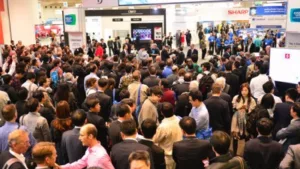The SID was a good event, again, this year, with a boost of 7% on attendance – a function of the location, we suspect, and the increased marketing activity. We heard numbers were up nearly 17% on 2014 in San Diego – a good result in a difficult climate for technology events. Next year’s event will be in Los Angeles – the event staying on the West coast to make communications with Asia easier.

As I mentioned in my editorial last week, there were four big highlights for me. The announcements about efficient QDs that conform to the ROHS regulations, without an exemption was big, but, potentially, the news that QDs can be put into the place where the colour filter is now, is bigger. The result will be much brighter TVs that can really deliver the potential of HDR without running up against the cost and energy barriers of current technologies. It looks as though there might even be products in 2017 or 2018, so that is very interesting.
The second highlight is the news from Kyulux and Cynora (and, maybe, UDC) that they can develop OLED materials for deep blue that have long life and high efficiency, based on TADF materials. That has been one of the breakthroughs that OLED developers have been looking for for many years. Nobody is quite there yet, but there is a huge amount of activity going on to make it happen. At SID and AWE this week, OLEDs looked really good again, but the blue lifetime has been a big barrier for a long time. Kateeva also said that it thought it could start printing OLEDs soon and that would also be a big breakthrough, although I have heard that expectation before, several times, from other companies, so I reserve judgement on that, for now.
E Ink showed a very good looking colour display, without using colour filters that was way, way better than anything seen in colour before. That could open up a number of digital signage and other applications, although the speed of the display is still slow and it won’t be commercial for another couple of years.
Finally, ClearInk looks as though it may have made the breakthrough to colour, video rate, reflective displays based on EPD technology and with high brightness. It’s early days for that company, as well, but the technology looks good, despite the early stage, and the company has assembled a very strong team of people to try to bring it to market.
Elsewhere, LG Display showed its fantastic looking 77″ HDR OLED TV and there were lots of great automotive displays, in LCD and OLED and both rigid and flexible. There were new shapes and form factors to allow auto designers huge freedom in their new products. There were also developments in resolution with several displays over 1000 ppi and 8K panels starting to be seen from JDI, BOE and LG.
Samsung showed its rollable OLED for the first time in public, I think, although we heard at the conferences that there remain challenges in developing a cover lens that can meet the requirements for robustness and protection.
At the Business and Investors’ conferences, IHS gave some very good data that helped also to see how the economic and production landscape would evolve. Our team has enjoyed creating our report – we hope you enjoy reading it – I welcome feedback to [email protected]

